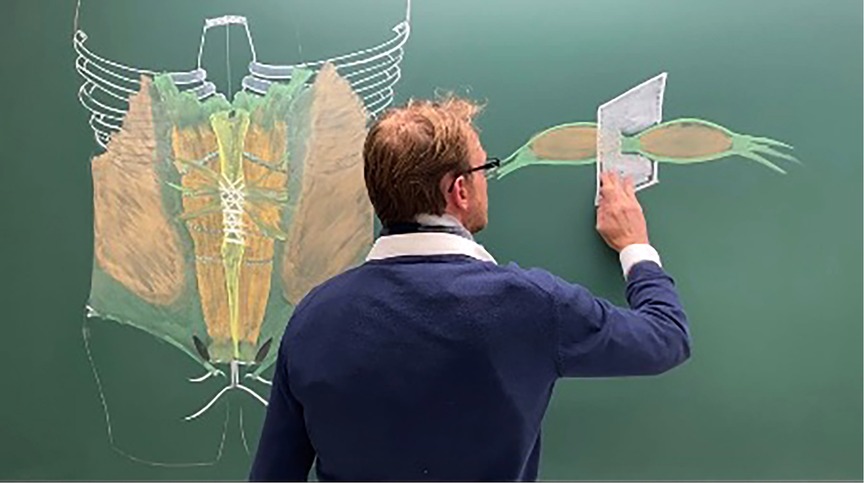
95% of researchers rate our articles as excellent or good
Learn more about the work of our research integrity team to safeguard the quality of each article we publish.
Find out more
EDITORIAL article
Front. Surg. , 26 September 2022
Sec. Visceral Surgery
Volume 9 - 2022 | https://doi.org/10.3389/fsurg.2022.1031593
This article is part of the Research Topic Hernia Related Anatomy in Abdominal Wall Surgery View all 8 articles
Editorial on the Research Topic Hernia related anatomy in abdominal wall surgery: Applied research in hernia repair by Konschake M, Mayer F, Fortelny RH. (2022) Front. Surg. 9: 1031593. doi: 10.3389/fsurg.2022.1031593
This special issue of Frontiers in surgery concerning the research topic “Hernia Related Anatomy in Abdominal Wall Surgery” addresses research in the field of Applied Anatomy, Human Embryology and Hernia Surgery. All the original articles and reviews presented are dealing with important facts with the goal of placing its findings to an interested broader surgical community.
Without having detailed knowledge in anatomy surgeons will quickly get into troubles. As this kind of knowledge usually is acquired during university studies, there is a strong need to transpose this knowledge later into clinical practice. Doing this needs clinical mentors being well trained in teaching Anatomy or dedicated post-graduate courses to specific fields of surgery – such as the Hernia Compact Course of The German Hernia School (1) in Abdominal Wall Reconstructive (AWR) Surgery – with the help of specialists in Applied Anatomy, who know to “speak the language of clinicians”. Beside that it needs surgeons, who have deep insights in the science of Anatomy. Yohann Renard, a surgeon and anatomist at the university of Reims (France), can be denominated as being a perfect representative of a handful of surgeons worldwide who are highly competent in explaining detailed anatomical knowledge to clinicians (Figure 1). By writing a paper to this issue in Frontiers of Surgery, Andreas Lorenz, a surgeon at the university of Innsbruck (Austria), has imparted detailed anatomical knowledge of the preperitoneal space, the transversalis fascia and the urogenital fascia - which are of highest relevance for many different techniques in incisional hernia repair and minimally invasive techniques in groin hernia surgery - into the surgical community. Another issue of prevention is knowledge of neuroanatomy especially in the groin as recently published by our Austrian Hernia Group (2), which established an annual workshop regarding this topic.

Figure 1. Prof. Dr. Yohann Renard, Department of Surgery, Department of Anatomy, University Hospital Reims (France).
In recent years, surgery of the abdominal wall has evolved massively with new techniques especially various techniques for myofascial-release of the abdominal wall, such as transversus abdominis release (TAR). New insights to the operation field (minimal-invasive or robotic techniques) require new ways for access to anatomical layers needing special anatomic training for example by cadaver workshops. In order to avoid complications, such as injuries to nerves and vessels, but also unphysiological separations of musculoaponeurotic structures, anatomical knowledge is required to a special degree. The contributions of this publication are therefore essential to expand this knowledge.
This issue comprises highly qualified papers, which provide interesting findings in human embryology of the anterior abdominal wall and associated malformations. These articles will lead to a better understanding of the development of the abdominal wall, possible herniations and therefore of surgical repair of abdominal and diaphragmatic pathologies.
MK, FM, and RF contributed to the conception, design and writing of the editorial. All authors contributed to editorial revision, read, and approved the submitted editorial.
Written informed consent was obtained from the individual(s) for the publication of any identifiable images or data included in this article.
The authors declare that the research was conducted in the absence of any commercial or financial relationships that could be construed as a potential conflict of interest.
All claims expressed in this article are solely those of the authors and do not necessarily represent those of their affiliated organizations, or those of the publisher, the editors and the reviewers. Any product that may be evaluated in this article, or claim that may be made by its manufacturer, is not guaranteed or endorsed by the publisher.
1. Lorenz R, Stechemesser B, Reinpold W, Fortelny R, Mayer F, Schröder W, et al. Development of a standardized curriculum concept for continuing training in hernia surgery: german hernia school. Hernia. (2017) 21(2):153–62. doi: 10.1007/s10029-016-1566-7
2. Konschake M, Zwierzina M, Moriggl B, Függer R, Mayer F, Brunner W, et al. The inguinal region revisited: the surgical point of view: an anatomical-surgical mapping and sonographic approach regarding postoperative chronic groin pain following open hernia repair. Hernia. (2020) 24(4):883–94. doi: 10.1007/s10029-019-02070-z
Keywords: surgery, hernia, applied anatomy, embryology, abdominal wall reconstruction (AWR)
Citation: Konschake M, Mayer F and Fortelny RH (2022) Editorial: Hernia related anatomy in abdominal wall surgery: Applied research in hernia repair. Front. Surg. 9:1031593. doi: 10.3389/fsurg.2022.1031593
Received: 30 August 2022; Accepted: 31 August 2022;
Published: 26 September 2022.
Edited by:
Gabriel Sandblom, Karolinska Institutet (KI), Sweden*Correspondence: Marko Konschake bWFya28ua29uc2NoYWtlQGktbWVkLmFjLmF0
Specialty Section: This article was submitted to Visceral Surgery, a section of the journal Frontiers in Surgery
© 2022 Konschake, Mayer and Fortelny. This is an open-access article distributed under the terms of the Creative Commons Attribution License (CC BY). The use, distribution or reproduction in other forums is permitted, provided the original author(s) and the copyright owner(s) are credited and that the original publication in this journal is cited, in accordance with accepted academic practice. No use, distribution or reproduction is permitted which does not comply with these terms.
Disclaimer: All claims expressed in this article are solely those of the authors and do not necessarily represent those of their affiliated organizations, or those of the publisher, the editors and the reviewers. Any product that may be evaluated in this article or claim that may be made by its manufacturer is not guaranteed or endorsed by the publisher.
Research integrity at Frontiers

Learn more about the work of our research integrity team to safeguard the quality of each article we publish.